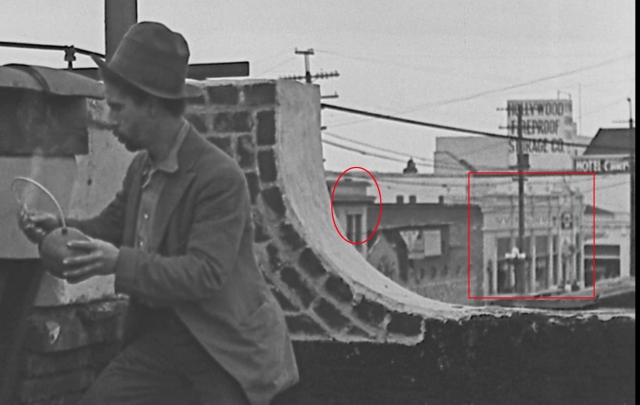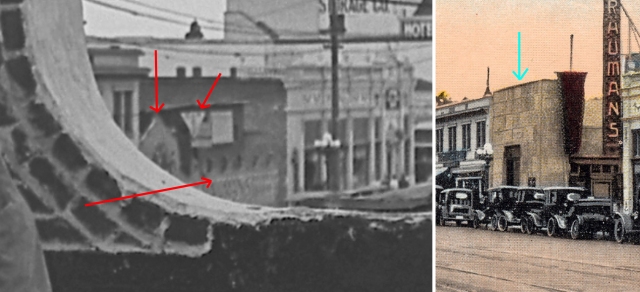
What do I do with this now? Buster blithely lights a cigarette in Cops.

Buster on parade, filmed in 1922 at the Goldwyn Studio in Culver City, prior to the creation of M-G-M in 1924.
At one point during Buster Keaton’s most famous short film Cops (1922), Buster finds himself and his newly acquired horse-cart full of furniture in the middle of the annual Policeman’s Day Parade. After politely tipping his hat in recognition to the parade-route crowds, Buster pulls out a cigarette and fumbles for a light. At that moment, an anarchist (an overused silent comedy trope, but grounded in real-life tragedies such as the 1920 Wall Street bombing and 1910 Los Angeles Times Building bombing) tosses a bomb from a rooftop that lands conveniently on Buster’s bench. While other comedians at the time might have mugged hysterically reacting to this predicament, Buster blithely notices the sputtering fuse, puts the flame to good use to light his cigarette, and then serenely ponders how to dispose of the no-longer-useful object. The brief scene is one Keaton’s most iconic, a three-second long vignette of Buster’s unique persona.
As revealed in this story, the amazing detail in the new Kino Lorber Blu-ray release of Keaton’s films allows us to solve where this rooftop scene was filmed, and discover its amazing connection to two venerable Hollywood institutions; the legendary eatery Musso & Frank, and Grauman’s Egyptian Theater, today home to The American Cinematheque.

Looking west – the bomber atop 6667 Hollywood Blvd., current site of the Musso & Frank Grill – the original grill site at 6669 stands next door out of view. The oval and box (match below) flank the Egyptian Theater under construction.

Looking east – the oval and box flanking the theater match those above. Courtesy Tommy Dangcil
It turns out the anarchist was standing on the rooftop of 6667 Hollywood Boulevard, the modern day home to the Musso & Frank Grill restaurant, founded in 1919. But at the time of filming (in 1922), the original (and shorter) Musso & Frank building (at 6669), stood immediately next door to the west, just below view behind the bomber. I solved this puzzle by reckoning from the Hollywood Fireproof Storage Building visible in the background of the movie frame. It still stands today, reconfigured in 1935 as the Max Factor Building on Highland Avenue, and now home to the Hollywood Museum. The arrows at left, and below, all point west down Hollywood Boulevard from the rooftop corner where the bomber stood (yellow oval). The blue line at left underscores the grill sign.

The original Musso & Frank Grill, at 6669 Hollywood Blvd. courtesy HollywoodPhotographs.com. The oval marks the west edge of 6667 Hollywood Blvd., the current home to Musso & Frank. The arrow points west in both images.

This circa 1928 view looks east – the palm trees in front of the Hotel Hollywood stand at the lower left corner of Hollywood and Highland. Los Angeles Public Library.
Below, a final overview aligning the rooftop bomber and the Hollywood Storage building.

Click to enlarge – Hollywood Then (1926) and Now. (A) marks the Hotel Hollywood, now (B) the Hollywood and Highland entertainment center (there are red carpets in the street for the Oscar ceremonies), (C) the First National Bank tower (completed in 1928), (D) the Hollywood Fireproof Storage building, now the Hollywood Museum, (E) the Montmartre restaurant building, (F) the Hotel Christie (opened in 1923), (G) the south end of the Egyptian Theater forecourt (opened in 1922), (H) 6669 Hollywood Blvd. (the original Musso & Frank site), and (I) 6667 Hollywood Blvd., the current Musson & Frank site. b&w image HollywoodPhotgraphs.com – color image (C) 2012 Google.
There is more to this story. George Wead’s bibliography of Keaton reports that Buster filmed Cops between December 1921 and January 1922 (thanks David B. Pearson). Though a bit difficult to discern, the rooftop bomber shot also provides an early view of the Egyptian Theater site, taken ten months or so before the theater opened. The Los Angeles Times reported, following a May 7, 1921 dedication ceremony, that construction of Sid Grauman’s so-called Hollywood Theater was planned to start May 9, 1921, and that with rushed construction it was anticipated to open by November 1921. A later November 4, 1921 story said that barring unforeseen circumstances the theater would likely open by February 1922. Yet the theater did not open until October 18, 1922, with the premiere of Douglas Fairbanks’s epic adventure Robin Hood.

Close-up view of Egyptian Theater construction site. I believe the triangle (right red arrow) is a street car traffic sign, suspended from a wire across the street. The bottom arrow points across what appears to be the top edge of billboards pasted on a construction site fence fronting the sidewalk. The mystery is the left arrow, pointing down toward a pitched face building that appears to have Gothic-arched windows. A tall, block-shaped Egyptian-style structure (blue arrow) was later built at this spot.
The theater is known for its large forecourt fronting Hollywood Boulevard, framed to the east by a long narrow commercial building forming one side of the court leading to the theater doors (see below). It appears from the frame above that at one time the face of this commercial wing had a different style than the tall, block-shaped face that was later built.

The bomber (oval) and the tall false front face to the Egyptian commercial wing (box).
You can see on the above image that the commercial wing is only one story tall, and that the tall blocked-shaped face of the wing (box) is a false front. So maybe the face of this wing was originally the pitched-roof face visible in the Keaton frame.

Above, the original Egyptian Theater forecourt – the blue arrow marks the tall, two-story false front to the one story commercial wing. The Dunn’s Men’s Shop, to the right of the forecourt (yellow oval), appears in Harold Lloyd’s 1921 short comedy Never Weaken. The store was replaced by the Pig ‘N Whistle restaurant in 1927.

Harold also filmed at the corner of Hollywood Blvd. and McCadden Place, as shown.
Cops is licensed by Douris UK, Ltd., and available as part to the Kino Lorber Buster Keaton: The Short Film Collection (1920-1923).
HAROLD LLOYD images and the names of Mr. Lloyd’s films are all trademarks and/or service marks of Harold Lloyd Entertainment Inc. Images and movie frame images reproduced courtesy of The Harold Lloyd Trust and Harold Lloyd Entertainment Inc.



Reblogged this on Memoirs of a Mangy Loner .
LikeLike
Great to see another post, and one about old Hollywood too.
LikeLike
What it is status of Grauman’s Egyptian Theater today? It’s interesting that Fairbanks’ classic “Robin Hood” was the first film to be shown there. How the audience must have laughed when Fairbanks tells King Richard, “But sire, I am afeared of women.”!
LikeLike
Now operationg as the Cinemateque. Full history
http://cinematreasures.org/theaters/35
LikeLike
Thanks for the link, Jeff. Very informative!
LikeLike
Pingback: More Discoveries From Keaton’s Cops | Chaplin-Keaton-Lloyd film locations (and more)